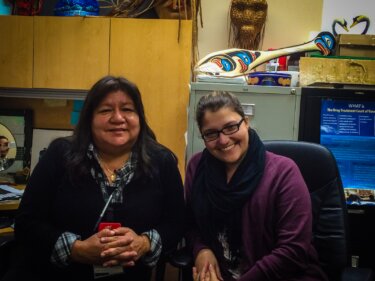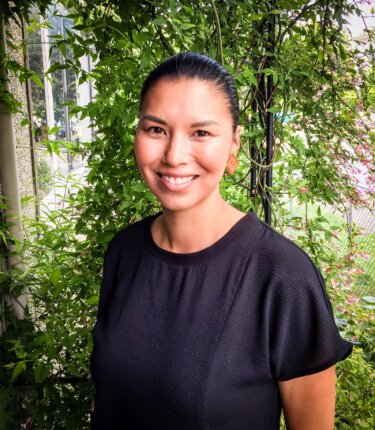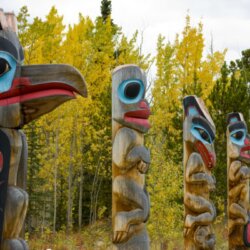Healing the Canadian justice system
First Nations, Inuit and Métis people are disproportionately represented in the Canadian criminal justice system. As an attempt at a solution, Indigenous legal traditions have been introduced in some parts of Canada.

In the First Nations Court in New Westminster, B.C., Samson Cree Nation Elder Kathy Louis stands to speak to the judge, telling him that she will do what is necessary for the Indigenous person before him to get the help he needs. “I’m willing to make that extra effort,” she says.
Some participants, standing in front of 20 onlookers, are conversational while some are silent, but in all cases, the judge asks them how they are doing. “I hope you can keep working on your healing,” he says.
This May 2016 hearing is an example of a First Nations Court in action in New Westminster, where Indigenous offenders, or, as they are called in the court, participants, come to court once a month in a community setting with family, friends and elders.

Similar versions of these courts, and other Indigenous justice initiatives, have sprung up elsewhere in Canada as a response to the staggering incarceration rates of Indigenous people. More than a quarter of inmates in Canada’s prisons are Indigenous, despite making up only four per cent of the general population.
In its annual report, the Office of the Correctional InvestigatorHoward Sapers is the Correctional Investigator. His office releases an annual report to Parliament on the current state of corrections in Canada. argues that Indigenous overrepresentation in Canada’s prison system is a result of systemic discrimination, racist attitudes, economic and social disadvantage, violence, loss, trauma and substance abuse. Some have called the system a modern-day incarnation of residential schools.
To that end, these types of proceedings signal a growing change in Canadian law toward a more Indigenous concept of justice. But whether these initiatives will have a significant impact on Indigenous incarceration rates is far from clear.
The imperative to reconcile Canadian law
As part of her 2016 mandate, Minister of Justice and Attorney General of Canada Jody Wilson-Raybould was directed by the federal government to increase the use of restorative justice measuresRestorative justice measures help criminal offenders move towards rehabilitation instead of incarceration. Some examples include moving through alternative court processes and involving community members when making sentencing decisions. Section 718.2(e) of the Criminal Code states that "all available sanctions other than imprisonment that are reasonable in the circumstances should be considered for all offenders, with particular attention to the circumstances of Aboriginal offenders." as they apply to Indigenous people in Canada.
In a statement to the United Nations in early May, Wilson-Raybould told the audience that Indigenous nations “will change the way Canada is governed” and that “there is room in our country for different legal traditions and ways of governing.”
The final report of the Truth and Reconciliation Commission (TRC) also states that governments should help facilitate recognition of the rights of Indigenous nations to carry out justice in their communities through the implementation of Indigenous justice systems in a manner in line with both Canadian and international law.
When it comes to Indigenous lawsIndigenous law often includes protocols around hunting and fishing, for example, and more importantly how people are to treat and relate to each other and to the environment around them. specifically, which differ from nation to nation, the TRC calls on the federal government to “fund the establishment of Indigenous law institutes for the development, use, and understanding of Indigenous laws and access to justice in accordance with the unique cultures of Aboriginal peoples in Canada.”
‘One-dimensional’ laws
Shawna Davis, a Gitxsan woman who is learning Gitxsan lawGitxsan law is the law of the Gitxsan people. It has been in place since before Canada was settled.. The Gitxsan come from communities in northwestern B.C. along the Skeena River. , says First Nations courts do not go far enough when it comes to reconciling with Canada’s Indigenous people and they should assert their own laws, outside of the mainstream, colonial system.

“Before this colonial law forcefully positioned our people as savages running amuck with no idea of society or order, we had and still have an incredibly complex society that takes all living entities into consideration,” she says. “Colonial laws will always be one-dimensional, they will always be there to enforce, punish and implement fear into [our] people.”
Davis is learning about her people’s laws so that she can pass them on to her children. “The power of law was given to the people, the elders, the knowledge keepers. The people and clans would meet, discuss what needed to be done, come to an agreement as to what best fit the situation. Everything would be weighed, the natural laws, and what was best for the people.”
Every clan and neighbouring nation respect Gitxsan laws, Davis says. “Gitxsan law is law, by every definition.”
With Wilson-Raybould’s contention that there is room for different ways of governing, the challenge now becomes how to reconcile two very different value systems and what that means for people like those working through the courts in New Westminster.
First Nations Courts: a promising model?
Back in 1997, Provincial Court Judge Marion Buller had a “crisis of conscience.” Buller, the only First Nations provincial judge in B.C. and a member of the Mistawasis First Nation, was seeing many Indigenous people come before her in court.
That’s when she started the B.C. First Nations Courts. The idea was to create a contemporary court based on traditional knowledge of Indigenous elders. Buller’s thesis was that if the justice system better reflected Indigenous healing values, Indigenous people would be more likely to succeed instead of getting caught up in the current punitive system.
Including Indigenous justice in the existing system:
- the Tsuu T’ina Peacemaker Court in Alberta
- the Cree Court in Saskatchewan
- the Gladue Court in Toronto
- Court of the Kahnawá:ke near Montreal
- along with the B.C. courts: New Westminster First Nations Court; North Vancouver Aboriginal Court; Cknucwentn First Nations Court in Kamloops; and Duncan First Nations Court.
In B.C., any self-identifying Indigenous person who enters a guilty plea can apply to be heard before one of four First Nations Courts in the province. In New Westminster, Buller presides over matters that fall within her jurisdiction, including almost everything except murder charges.
The First Nations Courts in B.C. use peacekeeping principles, such as introducing everyone in the courtroom, allowing members of the gallery to offer their opinions, sitting on the same level as the judge and other forms of what is referred to as restorative justice. Every First Nations court session starts with an elder-led smudge, which uses a feather, abalone shell and sacred medicines. The cleansing smoke is considered to wash away bad energy.
Elders attending the New Westminster court, which sits once a month, are paid $100 per session. Elders take notes, consult with lawyers and speak with the judge when they feel it is necessary.
Dana-Lyn Mackenzie, a lawyer and associate director of Indigenous legal studies in the Peter A. Allard School of Law at the University of British Columbia (UBC), who has appeared in a B.C. First Nations Court on a pro bono basis, says involving elders in the system is a positive change.
“Sometimes as lawyers, it’s easy to get caught in your role of being an advocate. The elder is very good at reminding everybody of the many kinds of roles they can facilitate,” she says. The elders help everyone remember the lasting effects of residential school and other traumas.
Shelly Johnson, a SaulteauxThe Saulteaux are a branch of the Ojibwe nations. woman and professor of social work at UBC, says the First Nations Court humanizes the justice system. “It’s the pain and the fear underneath the offending behaviour that this court is really trying to get at,” says Johnson. “Sometimes I see the look on people’s faces like they can’t really believe that this is a court, they’ve never been treated with that kind of respect, or never had their humanity witnessed in such a public way before.”
After someone finishes their healing plan, the First Nations Court version of probation, she explains, there are a lot of tears as they take part in a blanketing ceremonyAccording to the Cowichan on Vancouver Island, a blanketing ceremony shows respect for those who have made an important contribution to the community. An individual is wrapped in and given a blanket to keep. with an elder. First Nations Court elders can help fill a void that people might have because their own grandparents are no longer alive or they were separated from their families because of the residential school system and other involuntary circumstances.
A healing plan is equivalent to a probation order or a sentence in the Canadian criminal justice system. Instead of a formal court order, the healing plan includes a piece of paper and outline of the medicine wheel that explains how to be spiritually, emotionally, physically and mentally well.
Participants often return to court a number of times for evaluation by the judge. If a person doesn’t show up to the First Nations Court on a specified date, they will be in breach of their court order, and still have to follow the direction of their probation officers.
The healing plan’s purpose, according to Legal Aid BC, is to help people move on and to help address the problems that get people in trouble with the law in the first place. It can be as short as three months, although most people stay in the system for about a year.
New ways of doing justice
With her knowledge of Gitxsan law, Shawna Davis is skeptical about whether Indigenous values can ever meaningfully be part of what remains a colonial legal structure. She doesn’t see creating alternative sentencing courts within the Canadian criminal justice system as the solution. “The question is: is Canadian law working for our people? I say no. Why? Because as a Nation, we had laws implemented thousands and thousands of years before colonial law came.”
While advocates believe those who go through First Nations Courts are less likely to end up back in the justice system, whether or not this is the case is unclear. Despite functioning for nine years, the impact of the initiative is relatively unstudied. Johnson is currently researching the program’s effectiveness and her results are forthcoming.
Neither court aides nor Judge Buller were able to provide statistics about how many people have gone through the courts in time for publication. But with only four courts in the province sitting only once a month, the First Nations Courts aren’t sufficient to make a measurable impact on incarceration rates on their own.
The First Nations Courts are a step in the right direction, Johnson says, but need to be launched in more B.C. communities. Not everyone who would benefit can travel to one of the four locations for their sentencing or other court dates, she says.
Because the First Nations Courts function within the regular court system, they require additional funding, especially if they are to scale up. Johnson points out that in order to be successful, the program needs additional support staff. That includes not only defence lawyers, Native courtworkersThe Native Courtworker and Counselling Association of British Columbia helps Indigenous people in the Canadian criminal justice system find counselling and other resources, and assists with court appearances and many other duties. and elders but also access to mental health counsellors and help with finding work and transitioning back into the communities, she says.

The Teslin Tlingit Council in the Yukon Territory created the Peacemaker Court, where court takes place on their territory and under their laws, not in a mainstream Yukon courtroom.
Teslin Chief Carl Sidney says that as long as any offences take place on settlement land or traditional territory, then the Council’s own Indigenous laws apply, to a certain extent. “We brought the offender in front of our Clan leaders and in front of the elders and talked about how much it affected them… they made amends and they had to cut wood for them, or get meat for them, or provide for them for a certain amount of time and that was their sentence.”
The Teslin Tlingit never had jails, says Sidney. “People’s lives have changed. [In] our system, we take them out on the land, and that’s what a lot of people are missing.”
While other programs within the regular system have dedicated funding, First Nations Courts are patched together from existing resources, according to Johnson’s research. “That’s not been the case with other problem-solving courts in B.C.,” she says. “For example, [for] the Downtown Community Court or Drug Treatment Court there were additional dollars.”
Johnson believes the lack of funding keeps Indigenous people marginalized, incarcerated and displaced. “Elders are some of our best chances to address that inequity. [They remind us] where we come from, who we are as Indigenous peoples, what our laws were and what our laws can be again.”
What is being done in your community to encourage and support the revitalization and recognition of Indigenous law as a way to resolve issues?
